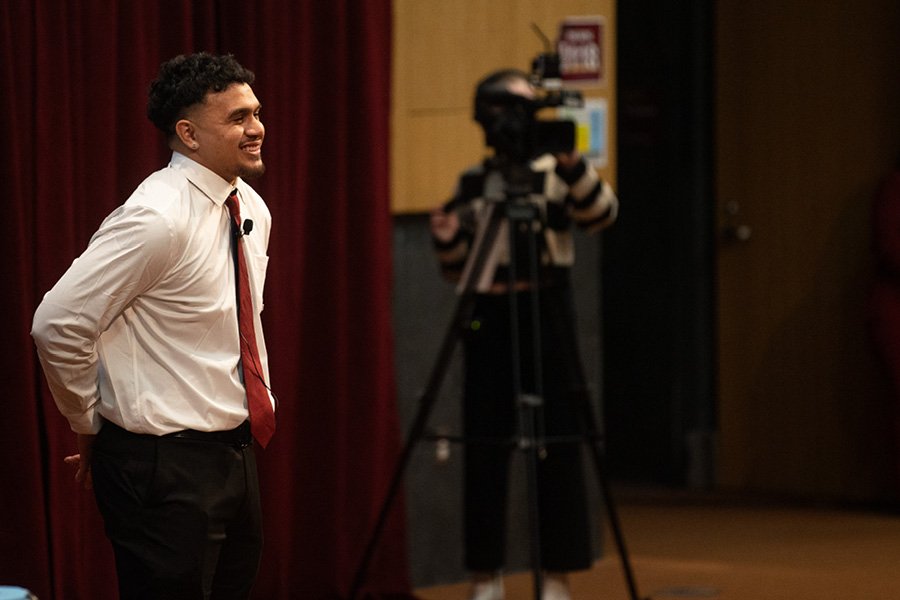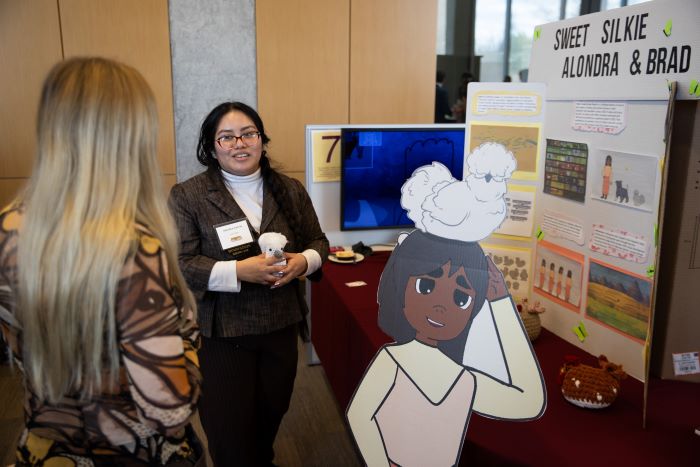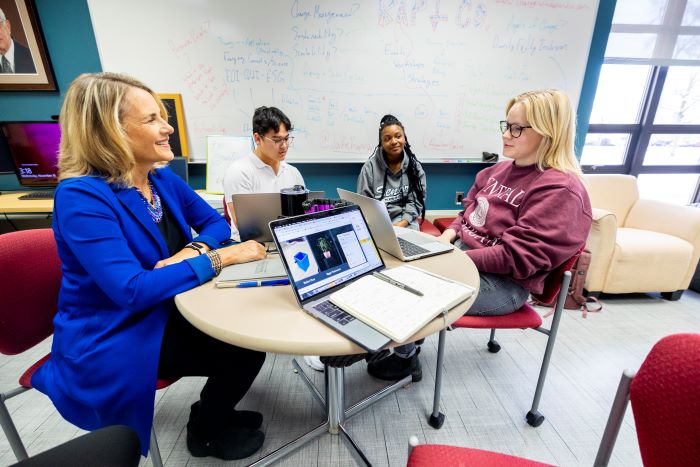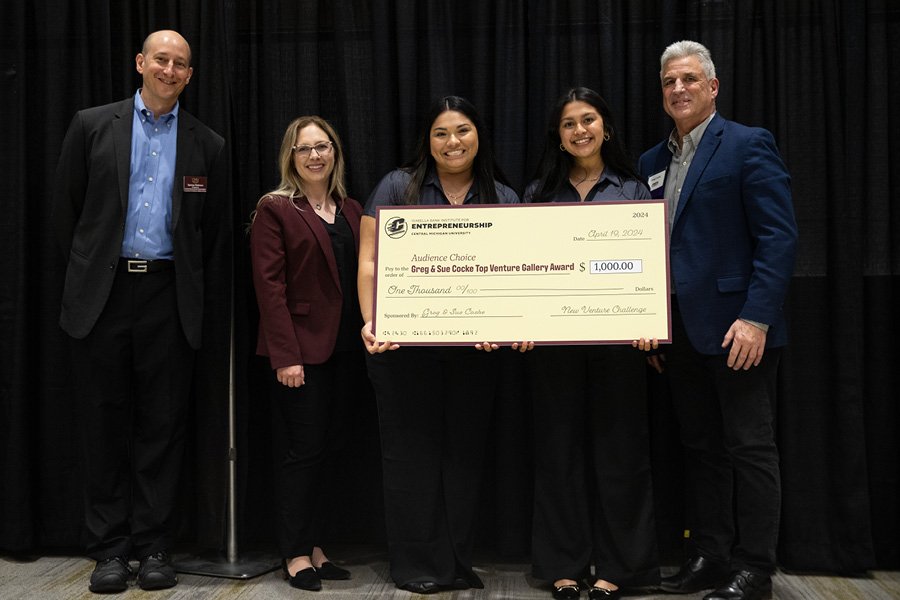
Start up
Passion. Potential. Pitches. Don't miss any of the 2025 New Venture Challenge excitement.
Tune in Friday, April 11 at 1 p.m. for great ideas and fierce competition. Then, join the judges, mentors, spectators and teams as they see who is going home with thousands of dollars in venture financing. The awards broadcast begins at 6:30 p.m. and one team will walk away as the overall best venture.
Central Michigan University’s College of Business Administration is the home of the Isabella Bank Institute for Entrepreneurship and the first Department of Entrepreneurship in the state of Michigan. We are a student-centric hub where experiential, curricular, and external entrepreneurial opportunities intersect.
Our mission is to maximize student success by fostering a campus-wide entrepreneurial mindset that promotes inter-disciplinary collaboration and the creation of new ventures.
We aim to create innovative programming, boost cross-campus and ecosystem collaboration and provide a comprehensive mentoring program.
Our institute provides extracurricular opportunities and is open to all undergraduate and graduate CMU students.
Are you interested in becoming an entrepreneur?
Every journey is unique. Explore the opportunities that interest you.
"Yay! We have more time to have fun," said Cecilia Lossio, a sixth grader at Sacred Heart Academy in Mount Pleasant, as she and her classmates ran chemical tests to determine the quality of the water they had collected from the Chippewa River.
That's the reaction hoped for by her teacher, Wendy Lemke, and the Central Michigan University student and faculty helpers.
Lemke and her students are taking part in a regional water quality experiment devised by chemistry and biochemistry faculty member Dale LeCaptain and Jamie Curtis-Fisk, a Dow Chemical Company scientist. The project, initially funded by Dow Corning (now Dow Chemical), will be presented at this year's central regional meeting of the American Chemical Society, whose members have worked alongside CMU volunteers.
The goal is to get middle school teachers and students excited about chemistry.
The method is to supply teachers with lesson plans and Environmental Protection Agency-quality water testing kits to use with their students in real-life situations so they can see how their work could make a difference in their own communities.
"Projects like this — doing real, impactful chemistry — engages teachers and students. That starts changing the perceptions of teaching and learning chemistry," LeCaptain said, noting that studies have shown that middle school is the best time to shape those perceptions.

It works like this. Once classrooms opt in and receive their materials, the teams march off to a local water source. They can test it just to learn its chemical makeup or use their results to see if the water is suitable for a goal, such as planting trout. That's what Lemke's students were wondering about the Chippewa River.
To find out, the students carried the supplied backpacks full of water testing kits to the river and measured such things as the speed of the water, its pH, temperature and turbidity (cloudiness).
Back in their school's labs, the students tested the water samples for dissolved oxygen, existence of nitrates and phosphate, conductivity, and pH to determine what kind of fish or other animals that environment could support.
While Lemke's students' tests showed that the pH and oxygen levels were perfect for trout, the team discovered that the turbidity was too high and the riverbed was too sandy for brook trout to spawn there, Lemke said.

The fun isn't over, however. The students will load their data onto an interactive map for all other participating middle schoolers in the Great Lakes Bay Region to compare with the results they found at their sites.
"As more schools enter their data points online, the more students can interact with each other by comparing results," LeCaptain said. "That creates a chemistry-linked fun competition and learning experience."
Once the map gets enough data points, he said, the information would become useful scientifically for spotting positive and negative trends.
He is confident the data map will continue to grow.
"This is exploding as a community outreach," he said.
The effort has already placed about 55 kits into area schools and community groups, and is expanding through the entire American Chemical Society's central region of Michigan, Ohio, West Virginia, and parts of Indiana and Pennsylvania, he said. Plans are already underway to expand to the 2020 regional meeting in Columbus, Ohio.

One of the reasons the endeavor is growing, LeCaptain said, is through the enlistment of CMU students and faculty to help the middle schoolers collect and test the data. It allows the middle school teachers to expose their students to chemistry without having to have the knowledge themselves.
"This is more powerful than having me guide the students alone," Lemke said. "My kids loved working with the CMU students, who were excellent teachers."
It also was a great learning opportunity for the five CMU environmental science students who helped out at the river and in the labs.
Each remarked on how much they enjoyed working with the students and being able to use in real-life situations what they've learned in their classrooms.

Explore special opportunities to learn new skills and travel the world.

Present your venture and win BIG at the New Venture Challenge.

Boost your entrepreneurial skills through our workshops, mentor meetups and pitch competitions.

Learn about the entrepreneurship makerspace on campus in Grawn Hall.

Present a 2-minute pitch at the Make-A-Pitch Competition and you could win prizes and bragging rights!

Connect with mentors and faculty who are here to support the next generation of CMU entrepreneurs.

Are you a CMU alum looking to support CMU student entrepreneurs? Learn how you can support or donate to the Entrepreneurship Institute.